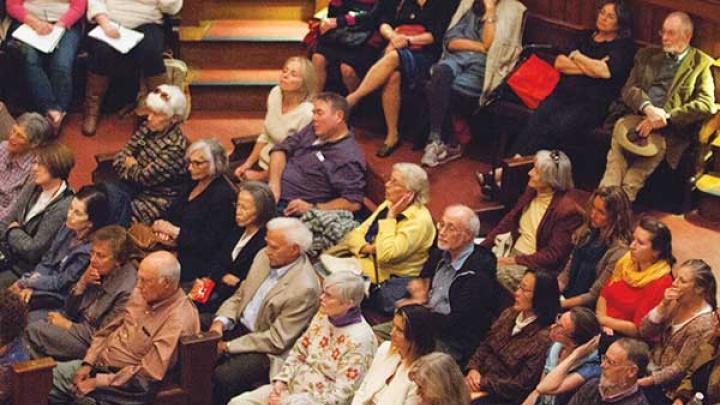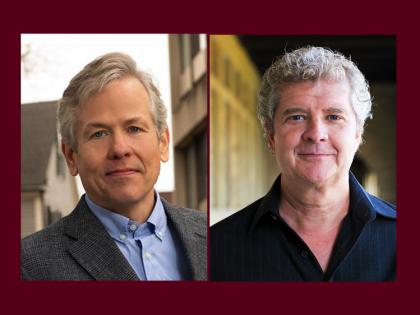When retired physician Ross Neisuler ’62, M.D. ’66, and his wife, Susan Gottsegen Neisuler, joined the Harvard Institute for Learning in Retirement (HILR) a decade ago, it soon became “the centerpiece of our lives,” he says. “It is not only a place to study and teach, but a community of enduring friendships, group trips abroad, music and art events, distinguished speakers, activity clubs for hiking, theatricals, committees, and volunteer work. It is a way of life.”
A branch of Harvard’s Division of Continuing Education, HILR was established in 1977 and offers peer-to-peer teaching and learning, along with year-round events. Long housed in shared, and sometimes cramped, classrooms at 51 Brattle Street, the organization will more than double its space this September, says HILR director Leoni Gordon, by moving into the “grand and spacious former Bunting Institute,” at 34 Concord Avenue, just outside Harvard Square.
The 10,000-square-foot building was renovated by architect Graham Gund, M.Arch. ’68, M.A.U. ’69, in 1989, but when HILR signed a five-year lease, the structure had been vacant since 2009. Construction during the summer was slated to make the building handicapped accessible and create a variety of new spaces for HILR’s 550 members. Along with classrooms, a large lecture hall-cum-performance venue, a library, and a technology center, the building has a writing room, art studios with skylights, a full kitchen, and a common room that fits up to 90 people for daily brown-bag lunches. “There is a high level of sociability here,” Gordon explains. “We have a very devoted membership, and we are a major service to people who live in Greater Boston and like to learn. It would appeal to alumni, a lot of whom don’t know about it.”
HILR follows the peer-teaching model established in 1962 by the New School for Social Research’s Institute for Retired Professionals, in Manhattan. The notion is that active people who are no longer devoted to full-time careers, but who have a wealth of knowledge and experience, may enjoy continued learning and teaching among like-minded colleagues. Such opportunities have grown exponentially in the last few decades, and similar programs are affiliated with Tufts, Lasell College, and Brandeis—but “We have the most academic program of this kind in the country,” says Gordon, who has led HILR for 18 years (and has worked at Harvard for 40). “That’s our reputation and it’s important to uphold that core. People come here to learn about everything from philosophy to Shakespeare to quantum physics.”
Each semester HILR offers up to 70 courses that meet once a week for two hours. Weekly reading is required, but the absence of tests, papers, and grades, Ross Neisuler points out, allows people to focus on “the fun of learning. People purposely study in fields which are new and initially strange to them.” Recent courses have covered the poetry of Seamus Heaney, Mexican muralists, George Eliot and Middlemarch, the language of DNA, the life and times of Bayard Rustin, African women writers, and China’s twenty-first century transformation. (Visit http://hilr.dce.harvard.edu for additional offerings, or attend this year’s annual HILR Cobb Memorial Lecture, which is free and open to the public: “The Second Machine Age: How Exponential Progress with All Things Digital Is Changing Our Economies and Societies,” featuring Erik Brynjolfsson and Andrew McAfee, co-founders of MIT’s Initiative on the Digital Economy, on October 1 in Sanders Theatre.)
About 40 percent of HILR members have a Harvard affiliation (alumni, faculty, or staff), Gordon says, but anyone can apply. Moreover, with the expanded quarters come broader membership criteria: members may now be semi-retired (instead of fully retired), and Gordon will add a second-tier “associate membership” for those who want to try out classes and/or only want to attend HILR events. (Full membership is $800 and associate membership is $150 annually.) With controlled growth, Gordon adds, the expanded space can accommodate 50 to 80 new members each year. The prospect pleases Ross Neisuler. “HILR certainly made me feel a lot better about aging,” he attests, “just by showing me how accomplished, stimulating, creative, and energetic people can be, many into their eighties and some in their nineties.”









